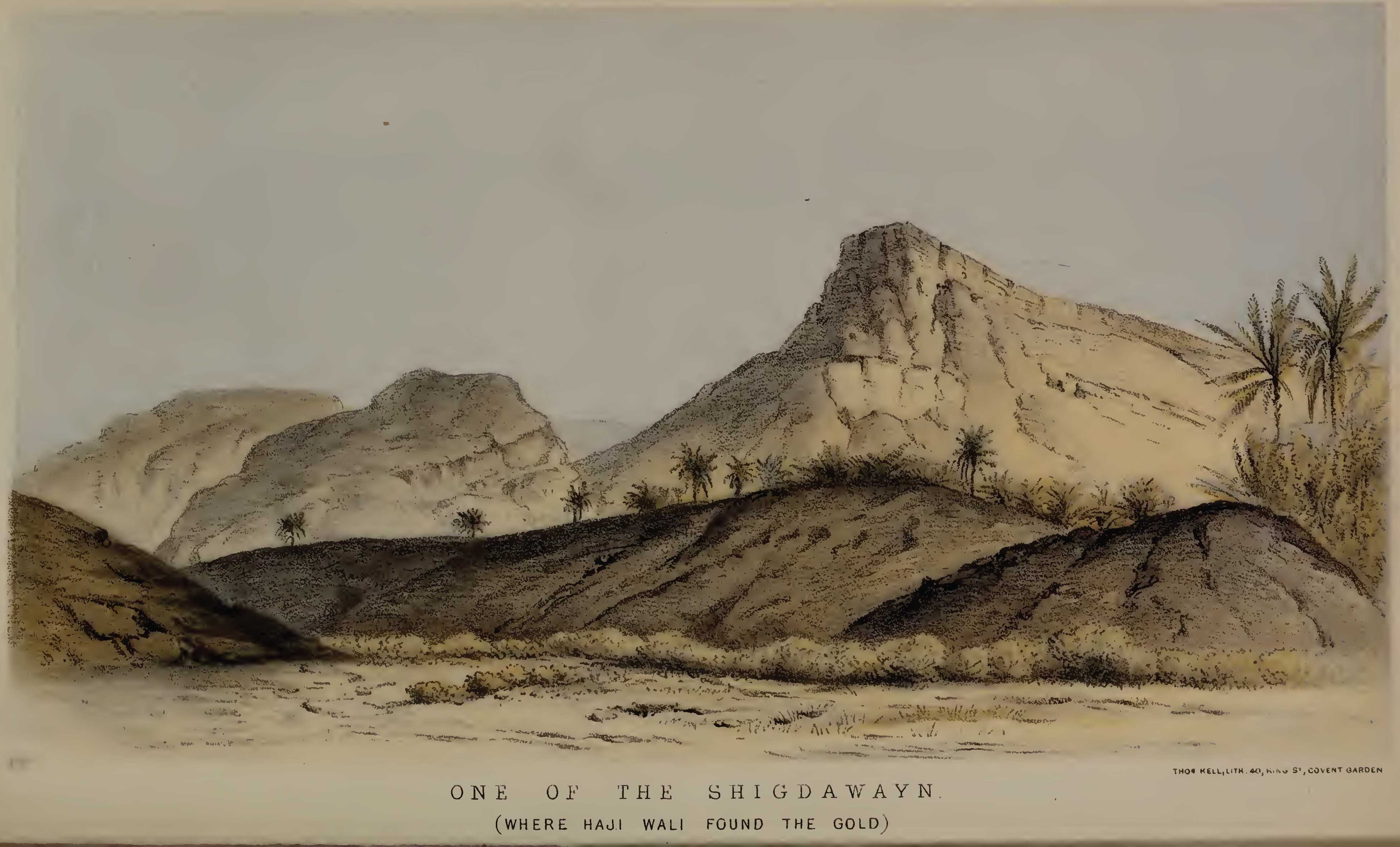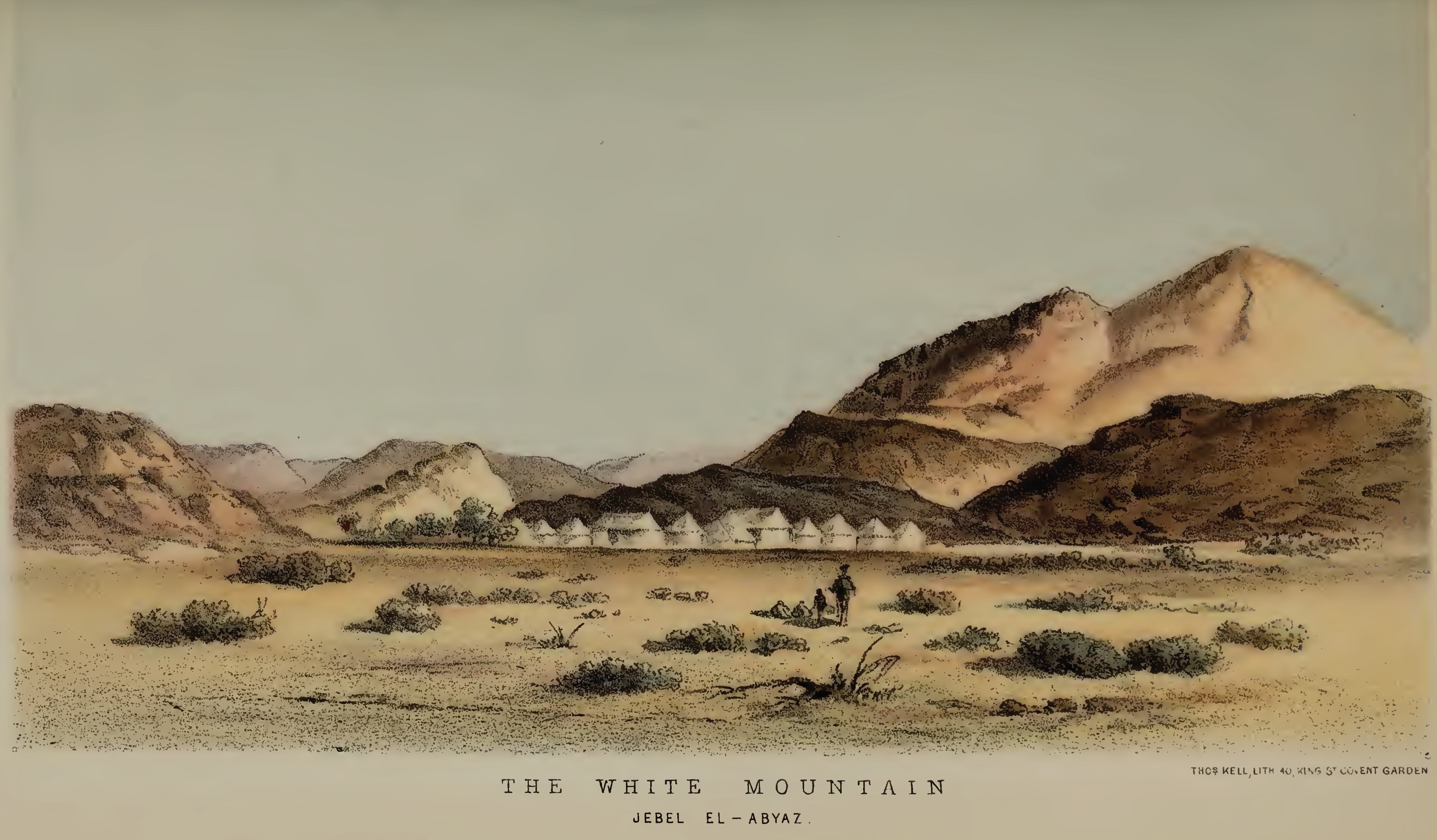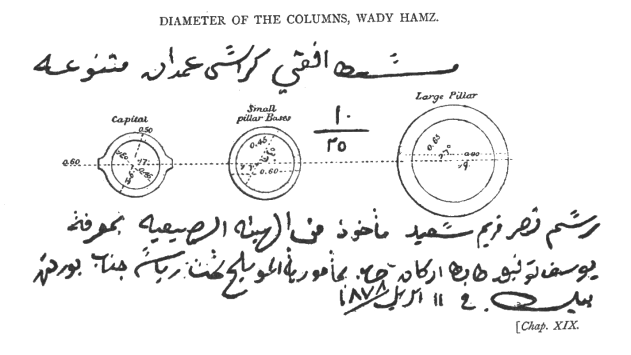



The Land of Midian (Revisited)
First edition of 1879 in two volumes.
London: C. Kegan Paul & Co.
Volume 1 PDF Page Images.
Volume 2 PDF Page Images.
HTML Transcription from etext.library.adelaide.edu.au
PREFACE.
A few pages by way of “Forespeache.”
The plain unvarnished tale of the travel in Midian, undertaken by the second Expedition, which, like the first, owes all to the liberality and the foresight of his Highness Ismail I., Khediv of Egypt, forms the subject of these volumes. During the four months between December 19, 1877, and April 20, 1878, the officers employed covered some 2500 miles by sea and land, of which 600, not including by-paths, were mapped and planned; and we brought back details of an old-new land which the civilized world had clean forgotten.
The public will now understand that one and the same subject has not given rise to two books. I have to acknowledge with gratitude the many able and kindly notices by the Press of my first volume (“The Gold Mines of Midian,” etc. Messrs. C. Kegan Paul & Co., 1878). But some reviewers succeeded in completely misunderstanding the drift of that avant courier. It was an introduction intended to serve as a base for the present more extensive work, and—foundations intended to bear weight must be solid. Its object was to place before the reader the broad outlines of a country whose name was known to “every schoolboy,” whilst it was a vox et praeterea nihil, even to the learned, before the spring of 1877. I had judged advisable to sketch, with the able assistance of learned friends, its history and geography; its ethnology and archaeology; its zoology and malacology; its botany and geology. The drift was to prepare those who take an interest in Arabia generally, and especially in wild mysterious Midian, for the present work, which, one foresaw, would be a tale of discovery and adventure. Thus readers of “The Land of Midian (Revisited)” may feel that they are not standing upon ground utterly unknown; and the second publication is shortened and lightened—perhaps the greatest advantage of all—by the prolegomena having been presented in the first.
The purpose of the last Expedition was to conclude the labours begun, during the spring of 1877, in a mining country unknown, or rather, fallen into oblivion. Hence its primary “objective” was mineralogical. The twenty-five tons of specimens, brought back to Cairo, were inspected by good judges from South Africa, Australia, and California; and all recognized familiar metalliferous rocks. The collection enabled me to distribute the mining industry into two great branches—(1) the rich silicates and carbonates of copper smelted by the Ancients in North Midian; and (2) the auriferous veins worked, but not worked out, by comparatively modern races in South Midian, the region lying below the parallel of El–Muwaylah. It is, indeed, still my conviction that “tailings” have been washed for gold, even by men still living. We also brought notices and specimens of three several deposits of sulphur; of a turquoise-mine behind Ziba; of salt and saltpetre, and of vast deposits of gypsum. These are sources of wealth which the nineteenth century is not likely to leave wasted and unworked.
In geography the principal novelties are the identification of certain ruined cities mentioned by Ptolemy, and the “Harrahs” or plutonic centres scattered over the seaboard and the interior. I venture to solicit the attention of experts for my notes on El–Harrah, that great volcanic chain whose fair proportions have been so much mutilated by its only explorer, the late Dr. Wallin. Beginning with Damascan Trachonitis, and situated, in the parallel of north lat. 28 degrees, about sixty direct miles east of the Red Sea, it is reported to subtend the whole coast of North–Western Arabia, between El–Muwaylah (north lat. 27 degrees 39’) and El–Yambu’ (north lat. 24 degrees 5’). Equally noticeable are the items of information concerning the Wady Hamz, the “Land’s End” of Egypt, and the most important feature of its kind in North–Western Arabia. Its name, wrongly given by Wallin, is unknown to the Hydrographic Chart, and to the erudite pages of my friend Professor Aloys Sprenger, who, however, suspects with me that it may be the mouth of the celebrated Wady el-Kura. For further topographical details the reader is referred to the “Itineraries” of the Expedition, offered to the Royal Geographical Society of London.
Some of the principal sites were astronomically determined by Commanders Ahmed Musallam and Nasir Ahmed, of the Egyptian navy. The task of mapping and planning was committed to the two young Staff-lieutenants sent for that purpose. They worked well in the field; and their sketches were carefully executed whilst under my superintendence. But it was different when they returned to Cairo. The maps sent to the little Exposition at the Hippo-drome (see conclusion) were simply a disgrace to the Staff-bureau. My departure from Egypt caused delay; and, when the chart reached me, it was far from satisfactory: names had been omitted, and without my presence it could not have been printed. With the able assistance of Mr. William J. Turner, of the Royal Geographical Society, who found the work harder than he expected, it has been reduced to tolerable shape. Still, it is purely provisional; and, when mining operations shall begin, a far more careful survey will be required.
As regards archaeology, the second Expedition visited, described, and surveyed eighteen ruins of cities and towns, some of considerable extent, in North Midian, besides seeing or hearing of some twenty large Mashghal, apparently the ateliers of vagrant Gypsy-like gangs. This total of thirty-eight is not far short of the forty traditional Midianite settlements preserved by the mediaeval Arab geographers. Many others are reported to exist in the central or inland region; and fifteen were added by the South Country, including the classical temple or shrine, found upon the bank of the Wady Hamz before mentioned. The most interesting sites were recommended to M. Lacaze, whose portfolio was soon filled with about two hundred illustrations, in oil and water-colours, pencil croquis and “sun-pictures.” All, except the six coloured illustrations which adorn this volume, have been left in Egypt. His Highness resolved to embody the results of our joint labours in a large album, illustrated with coloured lithographs, maps, and plans, explained by letter-press, and prepared at the Citadel, Cairo.
The Meteorological Journal was kept by myself, assisted at times by Mr. Clarke. Mr. David Duguid, engineer of the Mukhbir, whose gallant conduct will be recorded (Chap. VIII.), and Commander Nasir Ahmed, of the Sinnar, obliged me by registering simultaneous observations at sea-level. The whole was reduced to shape by Mr. W. J. Turner, of the Royal Geographical Society.
My private collection of mineralogical specimens was deposited with Professor M. H. N. Story–Maskelyne. The spirit-specimens of zoology filled three large canisters: and the British Museum also received a hare and five birds (Mr. R. B. Sharpe); four bats (Rhinopoma) and a mouse; six reptiles, five fishes, thirty-five crustaceans, and about the same number of insects; five scorpions, six leeches, sixty molluscs, four echinoderms, and three sponges. Dr. A. Gunther (Appendix III.) determined and named two new species of reptiles. Mr. Frederick Smith (Appendix III.) took charge of the insects. Mr. Edward J. Miers, F. L.S., etc., described the small collection of crustaceae (Annals and Magazine of Natural History for November, 1878). Finally, Edgar A. Smith examined and named the shells collected on the shores of the ‘Akabah Gulf and the north-eastern recess of the Red Sea.
The main interest of the little hortus siccus was the Alpine Flora, gathered at an altitude of five thousand feet above sea-level. The plants were offered to Sir Joseph Dalton Hooker, of Kew; and Professor D. Oliver, of the Herbarium, has kindly furnished me with a list of the names (Appendix IV.). Mr. William Carruthers and his staff also examined the spirit-specimens of fleshy plants (Appendix IV.).
Mr. Reginald Stuart Poole, Keeper of Coins and Medals, and Mr. Barclay V. Head were good enough to compare with their rich collections the coins of ancient Midian found (Chap. III.), for the first time, at Maghair Shu’ayb1. Some years ago, Mr. Robert Ready, of the British Museum, had bought from a Jew, Yusuf Kalafat (?), a miscellaneous collection, which included about sixty of the so-called Midianitic coins. But the place of discovery is wholly unknown. The Assistant Keeper read a paper “On Arabian Imitations of Athenian Coins,” Midianitic, Himyaritic, and others, at a meeting of the Numismatic Society (November 21, 1878); and I did the same at the Royal Asiatic Society, December 16, 1878. The little “find” of stone implements, rude and worked; and the instruments illustrating the mining industry of the country, appeared before the Anthropological Section of the British Association, which met at Dublin (August, 1878), and again before the Anthropological Institute of London, December 10, 1878.
Finally, the skulls and fragments of skulls from Midian were submitted to Professor Richard Owen, the Superintendent of Natural History; and my learned friend kindly inspected the Egyptian and Palmyrene crania which accompanied them. The whole was carefully described by Dr. C. Carter Blake, Ph.D., before the last-named seance of the Anthropological Institute (December 10, 1878).
The tons of specimens brought to Cairo were, I have said, publicly exhibited there, and created much interest. But the discovery of a mining-country, some three hundred miles long, once immensely wealthy, and ready to become wealthy once more, is not likely to be accepted by every one. Jealous and obstructive officials “did not think much of it.” Rivals opposed it with even less ceremony. A mild “ring” in Egypt attempted in vain to run the Hamamat and Dar–For mines (Chap. III.) against Midian. Consequently the local Press was dosed with rumours, which, retailed by the home papers, made the latter rife in contradictory reports. To quote one case only. The turquoise-gangue from Ziba (Chap. XII.) was pronounced, by the inexpert mineralogists at the Citadel, Cairo, who attempted criticism, to be carbonate of copper, because rich silicates of that metal were shown at the Exposition. No one seemed to know that the fine turquoises of Midian have been sold for years at Suez, and even at Cairo.
There was, indeed, much to criticise in the collection, which had been made with a marvellous carelessness. But we must not be hard upon M. Marie. He is an engineer, utterly ignorant of mineralogy and of assaying: he was told off to do the duty, and he did it as well as he could—in other words, very badly. He neglected to search for alluvial gold in the sands. Every Wady which cuts, at right angles, the metalliferous maritime chains, should have been carefully prospected; these sandy and quartzose beds are natural conduits and sluice-boxes. But the search for “tailings” is completely different from that of gold-veins, and requires especial practice. The process, indeed, may be called purely empirical. It is not taught in Jermyn Street, nor by the Ecole des Mines. In this matter theory must bow to “rule of thumb:” the caprices of alluvium are various and curious enough to baffle every attempt at scientific induction. Thus the “habits” of the metal, so to speak, must be studied by experiment with patient labour, the most accomplished mineralogist may pass over rich alluvium without recognizing its presence, where the rude prospector of California and Australia will find an abundance of stream-gold. Evidently the proportion of “tailings” must carefully be laid down before companies are justified in undertaking the expensive operation of quartz-crushing. Hence M. Tiburce Morisot, a practical digger from South Africa, introduced at Cairo by his compatriot, M. Marie, to my friend M. Yacoub Artin Bey, found a fair opportunity of proposing to his Highness the Khediv (October, 1878) a third Expedition in search of sand-gold. The Viceroy, however, true to his undertaking, refused to sanction any “interloping.”
The highly distinguished M. Ferdinand de Lesseps, when en route to Paris, kindly took charge of some cases of specimens for analysis. But the poorest stuff had been supplied to him by M. Marie; and the results, of which I never heard, were probably nil. The samples brought to England, by order of his Highness the Khediv, were carefully assayed. The largest collection was submitted to Dr. John Percy, F.R.S. Smaller items were sent to the well-known houses, Messrs. Johnston and Matthey, of Hatton Garden, and Messrs. Edgar Jackson and Co., Associates of the Royal School of Mines (fourteen samples). Finally, special observations were made by Mr. John L. Jenken, of Carrington, through Mr. J. H. Murchison, of “British Lead Mines,” etc., etc., etc.; by Lieut.-Colonel Ross, the distinguished author of “Pyrology;” and by Lieut.-Colonel Bolton, who kindly compared the rocks with those in his cabinet. M. Gastinel–Bey’s analysis of the specimens brought home by the first Expedition will be found at the end of Chap. VIII.